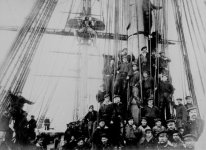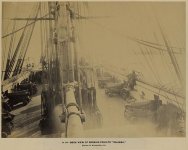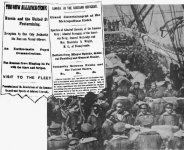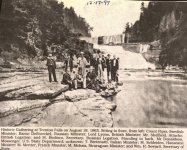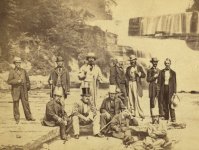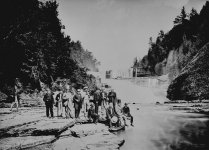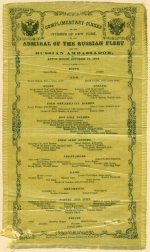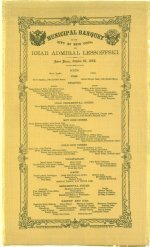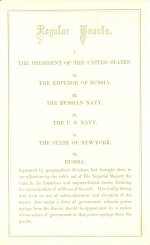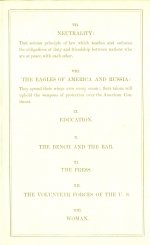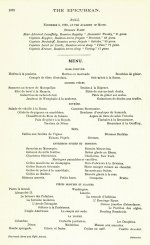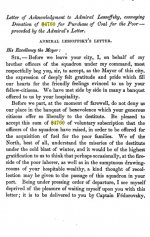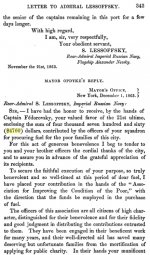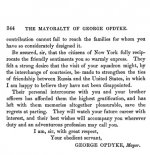Not many people in either country know that Russia helped the Union win the bloodiest conflict in US history. Under an agreement between President Abraham Lincoln and Russian Tsar Alexander II, Russia sent naval ships to the US to help Lincoln keep the country together.
A commemorative ceremony has been held by the grave of a Russian Navy sailor who died in Maryland during the American Civil War while helping the North fight the Confederates.
A "Bank Note"

If you share my level of ignorance, the entire involvement of Russia in the United States Civil War of 1861-1865 will come as a surprise. Hopefully, I am the only one who was oblivious to the fact. For me this journey started with the above banknote which is, in my opinion, being downplayed from whatever angle you choose to look. It is not really listed anywhere, where in depth information on it could be obtained. The Russian Czar Alexander II is being presented as some insignificant "military notable" who apparently does not deserve to be mentioned by name. And, in general, this banknote is being portrayed as an "advertising note". Never mind that "AMERICAN" above the image of the Russian Czar (Caesar), as well as the relative proportions of the images, could open up a huge can of worms.
I do smell a rat in the official version, and offer blog members to combine our investigative efforts. Something does not add up, and may be together we could discover a hidden fact, or two.
 This story is not a secret by any means, yet my history teacher chose not to mention it. In a nutshell, "Russia’s role in the Civil War was more palpable than just expressing diplomatic support. In September 1863, a Russian fleet of six warships headed to the East coast of North America and stayed there for seven months. Based in New York, they patrolled the surrounding area. A similar thing occurred in the West coast where a fleet of six warships was based in San Francisco. This helped to prevent sudden attacks of Southern raiders on these crucial Union port cities." Allegedly, the underlying purpose was to help dissuade Britain and France from siding with the Confederacy.
This story is not a secret by any means, yet my history teacher chose not to mention it. In a nutshell, "Russia’s role in the Civil War was more palpable than just expressing diplomatic support. In September 1863, a Russian fleet of six warships headed to the East coast of North America and stayed there for seven months. Based in New York, they patrolled the surrounding area. A similar thing occurred in the West coast where a fleet of six warships was based in San Francisco. This helped to prevent sudden attacks of Southern raiders on these crucial Union port cities." Allegedly, the underlying purpose was to help dissuade Britain and France from siding with the Confederacy.
Harper's Weekly, 7 November 1863
Harper's Weekly, 21 November 1863
Strange Coincidences




THE GRAND PROCESSION OF OUR RUSSIAN VISITORS THROUGH BROADWAY, UNDER ESCORT OF THE MILITIA AND POLICE.




I wanted to remind, that some things do not change when we take certain "weirdly strange" 19th century practices into consideration. One of those is going to be an obvious lack of photographs. Don't get me wrong here, some photos do exist, but as you can see above, the majority of the "establishment" type photographs were replaced with sketches. I will always question this practice. Instead of publishing actual photographs, they choose to give us drawings. It is obvious that reproducing drawings is a time consuming affair.
As you already know, making photographs was an established business (photography history) as early as 1840s. Therefore, the reasons for Harper's Weekly to be using drawings, are suspicious at the very least. To be honest, I do start thinking, that those weekly magazines could be a post production meant to deliver a specific narrative. In other words the drawings accompanied contents of the 19th century weekly magazines could be nothing but a made up story line.
Of course, we had to have the infamous Mathew Brady involved in the photograph producing activities pertaining to the 1863 Russian visitation.

A group of Russian soldiers, taken October 1863, courtesy Library of Congress
Just like I said above, there were some photographs made which do appear to be legit. At the same time those 5-6 (right) photographs give us nothing from the informational stand point.
And then we have our normal "photoshop" game, where the history makers had to create a photographic event. Judging by the appearance of the below "photograph" a reasonable person should be asking questions. The below photograph is related to the sequence of the events.
"In order to prevent foreign interference on behalf of the South, Lincoln's Secretary of State, William Seward, invited the foreign ministers of seven world powers on a tour of the North in 1863. Those world powers were Britain, France, Germany, Russia, Italy, Sweden and Nicaragua." - source. Nicaragua, for Christ's sake? Nicaragua was the world power in 1863?
KD: I can not stress enough the importance of the lack of photographic evidence. These sketches, in my opinion, are meant to replace the actual photographs which, if used, would reveal something unwanted by the Rulers of this World. As demonstrated by the above example, the photographs did exist, but for whatever reason they had to be redrawn and presented as sketches. Why?
"Not for some years has there been witnessed in San Francisco a fire of the same extent as that which commenced this morning, at about half-part one o'clock, in the rag store of Charley Orley... As far as we can learn, up to the hour of going to press, there are no lives lost. "

In the records we revealed about the death of sailors from diseases, deaths as a result of accidents, and about their burial on the shore or at sea, the time of each case is indicated. No evidence of the linkage of these deaths to the effects of the San Francisco fire was found in the documents. Of the three sailors, whose names and surnames are known to you, allegedly considered to be victims of the fire, one (A. Trapeznikov) died of typhoid fever. The cause of death of the other two in the journal entries, unfortunately, is not specified.
Their death is witnessed in the ship's journal "Bogatyr" with the following entries:
Above is the highest quality image I was able to locate. It would be interesting to find out the names of the Lady, and the Gentleman. They were clearly important enough for some editor of the past to highlight them in such a manner.
KD: It appears we could have two contradicting "cover up" type stories which did not get properly coordinated. At least six Russian sailors died in San Francisco in 1863. One version attributed their death to some "insignificant" San Francisco "fire". The other version blames alcohol poisoning, typhoid and negligent cannon handling type reasons. What really happened in San Francisco in 1863?
Rest assured, we do not have any definitive photographs pertaining to this historic 1863 event. There are a few attributed to the Riots, but with a different caption those photographs could pertain to just about anything. Instead we have hundreds of sketches; where are similar photos?

While I strongly doubt that the arrival of the Russian Atlantic Squadron is directly related to the Draft Riots, do we really know that it was not. That said, I do think that the Draft Riots have some serious disinformation included in the official narrative. The New York Riots of 1863 could probably make up a blog article of their own.
Meanwhile, two months later, the elite of the City of New York was indulging in multiple festivities held in honor of... the Russian Atlantic Squadron.
"Should this number of Harper's Weekly fall into the hands of some poor wounded fellow at Chattanooga, or some half-starved Union prisoner at Richmond, the contrast between his own condition and that of the scented and perfumed dancers who figure in the ball picture may not improve his temper. "They are fiddling while I am dying," is the remark which would not unnaturally occur to him, and it would leave a bitter taste behind". - source
KD: Here we have it - in the middle of the deadly Civil War, certain individuals are partying away in NYC. They do so to the point where the Russian Admiral Lessoffski can eat and drink no more.
KD Summary: I can not really make any sense out of the above non-sense. Sure enough, we have an official narrative of the events, but how does it account for the historical slippage of the Russian seaman Demidoff who died in Maryland in 1864? Where are all the photographs which allegedly do not exist? Where are the images of multiple Russian flags mentioned by Webster Griffin Tarpley in the above video?
Additionally, we have those bizarre coincidences where simultaneously the Russian Slavery, and the United States Serfdom come to an end. Was it the other way around, or was it exactly the same thing? Judging by the rights of the slaves vs. those of the serfs, the two were one and the same.
Of course we have the alleged purchase of Alaska in 1867. Did Russians actually get their hands on the money? Sounds like they did not. Was Alaska simply re-assigned?
Below is an image representing the advancement of the North American settlers to the West. There is no source for the below image. I snapped a picture of some youtube video a while back.

Columbus set foot on Hispaniola in 1492. Cortez overthrew the entire Aztec Empire by 1521. Pizarro conquered Peru and defeated Incas by 1535. Yet the North American settlers barely made it to the Mississippi river by 1820. 300 year difference is bizarre. Did North American natives have better defensive equipment? Well, may be they did. May be they had an army to defend themselves. The one we will never be told about.
And if we factor in all the other Civil War, and 19th century US related shenanigans, we have a mystery on our hands.

Color Symbolism in FlagsFlag colors differ from country to country and state to state; the colors presented hold deep-seeded meaning and representation.
A commemorative ceremony has been held by the grave of a Russian Navy sailor who died in Maryland during the American Civil War while helping the North fight the Confederates.
Grave of Russian sailor, Nikolay Demidoff, in Annapolis, MD

Russian sailor killed in US Civil War commemorated in Maryland
"He wasn't some trouble-maker who got into a silly adventure and was killed in a drunken brawl. American newspapers described his funeral as having been extremely formal, they describe his chestnut casket and a group of officers and other crew members who attended the funeral. A church service which largely impressed local Americans was also described," said Maksim Alekseyev, the head of Russia's memorial work department in the US.Russian sailor killed in US Civil War commemorated in Maryland
A "Bank Note"
Russia and New York, ND (ca.1865-1870), Advertising card with Lincoln and Grant flanking Russian Military Notable with Gryphons at base, also with small busts of Franklin and Washington similar to the portraits used on the early postage stamps of the U.S. on the LL and LR corners.
- American Bank Note Company Advertising Note From 1860's.
- American Bank Note Company Advertising Note From 1860's.
- Who is that gent with Lincoln and Grant? Alexander II.
If you share my level of ignorance, the entire involvement of Russia in the United States Civil War of 1861-1865 will come as a surprise. Hopefully, I am the only one who was oblivious to the fact. For me this journey started with the above banknote which is, in my opinion, being downplayed from whatever angle you choose to look. It is not really listed anywhere, where in depth information on it could be obtained. The Russian Czar Alexander II is being presented as some insignificant "military notable" who apparently does not deserve to be mentioned by name. And, in general, this banknote is being portrayed as an "advertising note". Never mind that "AMERICAN" above the image of the Russian Czar (Caesar), as well as the relative proportions of the images, could open up a huge can of worms.
I do smell a rat in the official version, and offer blog members to combine our investigative efforts. Something does not add up, and may be together we could discover a hidden fact, or two.
Imperial Russia supports the Union
At the point of maximum war danger between Great Britain and the United States, the London satirical publication Punch published a vicious caricature of US President Abraham Lincoln and Russian Tsar Alexander II, demonizing the two friends as bloody oppressors. From Punch, October 24, 1863- Expedition of the Russian fleet to the shores of North America (1863-1864)
- What role did Russia play in the U.S. Civil War?
- Russian Empire–United States relations
- Russian Fleet Expedition to North America: 1863-1864
- Russian Involvement in US Civil War
- The Bilateral Effect of the Visit of the Russian Fleet in 1863
- 150th Anniversary of Russian Navy’s Arrival in New York Harbor
- Our naval visitors: The Russian Fleet in the harbor. Sketches of the vessels, officers, etc.
Historian Webster Griffin Tarpley talked about the contribution of Russian Tsar Alexander II to a northern victory in the U.S. Civil War. He said that the Imperial Russian government had issued an ultimatum to Britain and France specifying that if those powers should intervene on the side of the Confederate States of America they would immediately find themselves at war with the Russian Empire. Mr. Tarpley marked the 150th anniversary of the arrival of the Russian Baltic Fleet in New York City on September 24, 1863, and of the Russian Pacific Squadron in San Francisco on October 12, 1863. He argued that it was the presence of those fleets that provided the final deterrence. Russia was the only country to extend direct military support to the Lincoln government.
The above quote was mentioned in the above video. I did not find any independent sources of this quote. I think the original version of the quote was in Russian language, and that makes it a bit harder to find the source.Russia will support in every way possible, and aid to the fullest extent of its power its ancient ally, the United States of America, in its struggle against treason. Under no circumstances will the Czar permit, if his efforts can prevent it, the success of the lately inaugurated rebellion against the laws, and the government of a friendly country.
1863: Russian Fleet in NY and SF
remained in the US for seven months
New York


Russia’s Atlantic Squadron, as the fleet was known, arrived in the New York harbor on September 24, 1863.remained in the US for seven months
New York
- Alexander Newsky (flagship) - was a screw frigate mounting 51 smooth-bore cannons
- Peresvet - was a screw frigate mounting 51 smooth-bore cannons
- Varyag - was a screw corvette mounting 17 cannons
- Oslyabya - was a screw frigate mounting 45 smooth-bore cannons
- Vityaz - was a screw corvette mounting 17 cannons
- Almaz - was a screw clipper mounting 7 cannons
- Bogatyr - a screw corvette with 17 cannons (other sources mention 48 cannons)
- Kalevala - a screw corvette with 15 cannons
- Rynda - a screw corvette with 9 cannons
- Novik - a screw corvette with 11 cannons
- Abrek - a screw clipper with 5 cannons
- Gaidamak - a screw clipper with 7 cannons
- June 28. The steamer Sierra Nevada arrived from the northern coast bringing treasure to the amount of $383,000. . . .An Englishman, named Wm. Sharn, committed suicide by taking strychnine. . . .The Russian corvette Rynda arrived from Japan via Sitka and Victoria.
- Sept. 28. U. S. sloop of war Cyane sailed on cruise. . . .Russian corvette Novick lost off Point Reyes. . . .Howard Street M. E. Church dedicated.
- Oct. 12. Russian corvette Bogatyre, 48 guns, 312 men arrived. . . .P. M. S. S. Constitution sailed with $1,183,327.
- Oct. 16. Russian corvette Guidmack arrived.
- Oct. 19. Dwelling house of Maurice Doyle, on Jones Street, was burned; two children lost their lives by the flames. . . .Lacari, Bruzzo, and Pizano were sentenced to imprisonment for life. . . .Calavala, Russian frigate, arrived.
- Oct. 29. Abreck, Russian corvette, arrived. . . .Sierra Nevada, from North, brings $265,265.
- Nov. 7. Russian corvette Rynda entered our harbor. . . .Liberty Hose Company housed their apparatus.
1863 Publications
Harper's Weekly, 17 October 1863Harper's Weekly, 7 November 1863
Harper's Weekly, 21 November 1863
Strange Coincidences
- Photography - where are the photographs?
THE GRAND PROCESSION OF OUR RUSSIAN VISITORS THROUGH BROADWAY, UNDER ESCORT OF THE MILITIA AND POLICE.
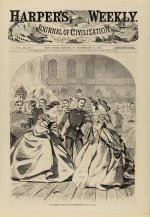
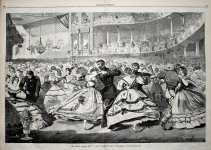
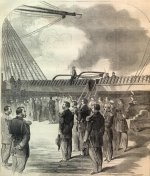
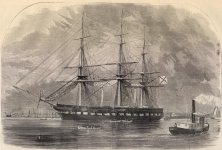
I wanted to remind, that some things do not change when we take certain "weirdly strange" 19th century practices into consideration. One of those is going to be an obvious lack of photographs. Don't get me wrong here, some photos do exist, but as you can see above, the majority of the "establishment" type photographs were replaced with sketches. I will always question this practice. Instead of publishing actual photographs, they choose to give us drawings. It is obvious that reproducing drawings is a time consuming affair.
As you already know, making photographs was an established business (photography history) as early as 1840s. Therefore, the reasons for Harper's Weekly to be using drawings, are suspicious at the very least. To be honest, I do start thinking, that those weekly magazines could be a post production meant to deliver a specific narrative. In other words the drawings accompanied contents of the 19th century weekly magazines could be nothing but a made up story line.
Of course, we had to have the infamous Mathew Brady involved in the photograph producing activities pertaining to the 1863 Russian visitation.
A group of Russian soldiers, taken October 1863, courtesy Library of Congress
Just like I said above, there were some photographs made which do appear to be legit. At the same time those 5-6 (right) photographs give us nothing from the informational stand point.
And then we have our normal "photoshop" game, where the history makers had to create a photographic event. Judging by the appearance of the below "photograph" a reasonable person should be asking questions. The below photograph is related to the sequence of the events.
"In order to prevent foreign interference on behalf of the South, Lincoln's Secretary of State, William Seward, invited the foreign ministers of seven world powers on a tour of the North in 1863. Those world powers were Britain, France, Germany, Russia, Italy, Sweden and Nicaragua." - source. Nicaragua, for Christ's sake? Nicaragua was the world power in 1863?
KD: I can not stress enough the importance of the lack of photographic evidence. These sketches, in my opinion, are meant to replace the actual photographs which, if used, would reveal something unwanted by the Rulers of this World. As demonstrated by the above example, the photographs did exist, but for whatever reason they had to be redrawn and presented as sketches. Why?
- San Francisco fire of 1863 - what a coincidence!
"Not for some years has there been witnessed in San Francisco a fire of the same extent as that which commenced this morning, at about half-part one o'clock, in the rag store of Charley Orley... As far as we can learn, up to the hour of going to press, there are no lives lost. "
We must not forget, however, to mention the noble spirit manifested by the Russian fleet now lying in the harbor, the commanding officers of which sent to the scene of conflagration nearly two hundred of their seamen, under the command, as we learned, of Lieut. Seraggen, Lieut Eholen and Lieut. Mackaoff. Each of these gallant " tars " came with a bucket; but our good firemen, whose appliances for combatting, with the destroying flame are of much more utility, urgently requested the sailors to throw aside their buckets and go to work on the engines. The Russian sailors responded with a good will, and continued until, like their competitors, they were, one by one, almost exhausted, when they took a few moments' rest and then again resumed their positions at the engines.
- SF: Tremendous Fire this Morning
- Friends in Peace and War: The Russian Navy's Landmark Visit to Civil War San Francisco
- October 23, 1863 San Francisco Fire receives assistance of Russian officers and sailors
- Interesting link: SF Events of 1863
This SF "Fire" of 1863 is being portrayed as insignificant. It did not even get its own Wikipedia page. Yet there is something strange about this Fire, if it indeed was the fire.Oct. 23. Block bounded California and Sacramento, Drumm and Davis streets, destroyed by fire; loss $300,000. . . .Steamer Sonora sailed with $793,555 22.
While locating any 1863 source pertaining to the death of six Russian Pacific Fleet sailors in San Francisco yielded no result, there was no shortage of the contemporary references.A gesture by the Russian government to honor six of its sailors who were buried in a San Francisco Bay area cemetery nearly 150 years ago is not sitting well with preservationists. The visiting Russian sailors died in 1863 while helping to fight a massive fire near San Francisco's waterfront. They were buried at the Navy cemetery on Mare Island, where weathered, broken stone slabs marked their graves for decades. To honor their heroism, the Russian Consulate decided last year to buy new cross-shaped, granite headstones for the burial sites of A. Trapeznikov, K. Kort, Y. Bootorin and three unidentified sailors.
- Russian headstones retain luster amidst sea of dilapidated U.S. veteran graves
- Russian American Naval History Mare Island, San Francisco Bay, California and the Pacific
- On Controversial Happenings at a Naval Cemetery
- HTC: Mare Island honors sailors who died in 1863 fire
In the records we revealed about the death of sailors from diseases, deaths as a result of accidents, and about their burial on the shore or at sea, the time of each case is indicated. No evidence of the linkage of these deaths to the effects of the San Francisco fire was found in the documents. Of the three sailors, whose names and surnames are known to you, allegedly considered to be victims of the fire, one (A. Trapeznikov) died of typhoid fever. The cause of death of the other two in the journal entries, unfortunately, is not specified.
Their death is witnessed in the ship's journal "Bogatyr" with the following entries:
- October 27 (November 8), 1863 at 9.30 am: "The sailor of the 1st article, Artemy Trapeznikov, died of typhoid fever";
- November 20 (December 2), 1863 at 7.30: "The musician Kort died";
- December 29, 1863 (January 10, 1864) at 9.30: "The sailor of the 1st article, Jacob Butorin, died".
- October 24 (November 5), 1863 at 12 o'clock: "Sailor Salyukas who is in the hospital on the shore died";
- 4 (16) December 1863 at 6 o'clock: "The sailor Dobrynin died from consumption";
- November 5 (17), 1863. "During the return salute to the American frigate Lancaster, the gun blew out while charging, throwing Fyodor Sharov, who was not found, and Vasily Kozlov was torn off by his left hand."
- Russian sailors on fire in San Francisco: imaginary death
- It was a military ball given to Admiral Popoff and thirty-five officers of the Russian fleet then anchored in the bay of San Francisco. The country was in the throes of civil war. The relations of the United States were, at best, strained with leading nations of Europe, except Russia. Russia had manifested the sincerest friendship to the Union. In recognition of its friendship New York made a great demonstration on the occasion of the visit of the Russian squadron to that harbor, and when the Pacific squadron under Admiral Popoff visited this bay it did not take long for patriotic San Franciscans to decide upon giving a similar friendly demonstration in Russia’s favor here.
- Admission was obtainable only by special invitation, and, with the exception of the guests, it cost $100 a ticket. But money was plentiful in those days, and it was easier to get a subscription of $100 for any cause than it is to get $5 now. Nearly 1000 invitations were sent out. Colonel William C. Little, afterward the agent of Mayor Adolph Sutre, was the Captain of the City Guard and the leading spirit in the movement, and his family still retains in possession, as precious mementos of the event, the memorandum book containing the invitation list and photographs of many of the Russian officers, with whom he was on terms of the closest personal friendship.
Above is the highest quality image I was able to locate. It would be interesting to find out the names of the Lady, and the Gentleman. They were clearly important enough for some editor of the past to highlight them in such a manner.
KD: It appears we could have two contradicting "cover up" type stories which did not get properly coordinated. At least six Russian sailors died in San Francisco in 1863. One version attributed their death to some "insignificant" San Francisco "fire". The other version blames alcohol poisoning, typhoid and negligent cannon handling type reasons. What really happened in San Francisco in 1863?
- New York City Draft Riots of July 1863 - probably unrelated to the Russian Fleet in NY!
- The most reliable estimates indicate at least 119 people killed, and 2,000 people were injured. Herbert Asbury, puts the figure much higher, at 2,000 killed and 8,000 wounded, a number that some dispute. Total property damage was about $1–5 million ($19.9 million – $99.4 million, adjusted for inflation). The city treasury later indemnified one-quarter of the amount.
Rest assured, we do not have any definitive photographs pertaining to this historic 1863 event. There are a few attributed to the Riots, but with a different caption those photographs could pertain to just about anything. Instead we have hundreds of sketches; where are similar photos?
Meanwhile, two months later, the elite of the City of New York was indulging in multiple festivities held in honor of... the Russian Atlantic Squadron.
"Should this number of Harper's Weekly fall into the hands of some poor wounded fellow at Chattanooga, or some half-starved Union prisoner at Richmond, the contrast between his own condition and that of the scented and perfumed dancers who figure in the ball picture may not improve his temper. "They are fiddling while I am dying," is the remark which would not unnaturally occur to him, and it would leave a bitter taste behind". - source
- Taken on face value as a goodwill gesture by Czar Alexander II, the naval visit generated a lot of excitement in New York. People lined Broadway, cheering the Russians as they paraded by in carriages, the streets festooned with the flags of both nations; Tiffany’s went so far as to decorate their entire building with a huge banner. On October 12th, the first banquet for Admiral Lessofsky was held at the Astor House, hosted by five hundred “citizens” of New York. The menu shown below is printed on yellow silk and features the great seals of both nations.
- A week later, there was another banquet at the Astor House for Admiral Lessofsky and his officers. Hosted by the City of New York, this dinner for two hundred gentlemen featured a particularly large number of ornamental centerpieces, the purely decorative sculptures made of confectionery. The menu shown below, surprisingly similar in appearance to the one from a week earlier, is printed on ribbed satin with a tighter weave, making it easier to read.
- Three days later, having barely digested the second banquet at the Astor House, the Russian officers (numbering over a hundred), left the city on a sightseeing trip to Niagara Falls, provided courtesy of the Hudson River Steamboat Company and the New-York Central and Erie Railroads. By then, the unrestrained flow of American hospitality, which included many private dinner parties, was beginning to take its toll on Admiral Lessofsky who accepted the invitation only on the condition that there not be any parades, speeches, or banquets during their five-day excursion.
- On November 5th, the much-anticipated ball for the Russians began at 9:00 in the evening, when the first carriages pulled up to the Academy of Music. Two thousand tickets were sold for the Soirée Russe, as this dance was called; the crowd of onlookers standing outside was estimated to be even larger, making the whole affair something of a mob scene. The Russians were astonished to learn that the theater had been converted to a ballroom in less than twenty four hours, the work beginning only after the opera closed at midnight the night before. “None but Americans could accomplish such a feat!,” they exclaimed when they saw the glittering scene.
KD: Here we have it - in the middle of the deadly Civil War, certain individuals are partying away in NYC. They do so to the point where the Russian Admiral Lessoffski can eat and drink no more.
- By then, the unrestrained flow of American hospitality, which included many private dinner parties, was beginning to take its toll on Admiral Lessofsky who accepted the invitation (to the 3rd ball) only on the condition that there not be any parades, speeches, or banquets during their five-day excursion.
KD Summary: I can not really make any sense out of the above non-sense. Sure enough, we have an official narrative of the events, but how does it account for the historical slippage of the Russian seaman Demidoff who died in Maryland in 1864? Where are all the photographs which allegedly do not exist? Where are the images of multiple Russian flags mentioned by Webster Griffin Tarpley in the above video?
Additionally, we have those bizarre coincidences where simultaneously the Russian Slavery, and the United States Serfdom come to an end. Was it the other way around, or was it exactly the same thing? Judging by the rights of the slaves vs. those of the serfs, the two were one and the same.
Of course we have the alleged purchase of Alaska in 1867. Did Russians actually get their hands on the money? Sounds like they did not. Was Alaska simply re-assigned?
Below is an image representing the advancement of the North American settlers to the West. There is no source for the below image. I snapped a picture of some youtube video a while back.
And if we factor in all the other Civil War, and 19th century US related shenanigans, we have a mystery on our hands.
- Funeral trains, flags, mummies or when did Lincoln really die?
- 1860s: Advanced Civil War weapons
- Where were US flags prior to the Civil War?
- 16th century Tartarian King Tartarrax ruled Quivira Regnum in North America
- Bizarre transformation of the North American Continent: 16th through 19th centuries
- Fire at Library in Moscow Destroys Millions of Volumes
- America burns a Moscow library, preserves hegemony
Color Symbolism in Flags
- Black: Often used to represent determination, ethnic heritage and/or the defeat of enemies. It can also be used as a symbol of death or mourning.
- White: Seen as a symbol of peace, purity and harmony, and has also been used to represent surrender in times of battle.
- Red: Stands for power, revolution, vibrancy and war (symbolic of bloodshed). Other meanings include courage and domination, while it can also be viewed as an alert of danger.
- Blue: Signifies determination, liberation, alertness and good fortune.
- Green: Often seen as a symbol of agricultural influence, as well as prosperity and fertility. It can also be viewed as youthfulness and hope.
- Yellow (or Gold): Has long been viewed as a symbol of wealth and energy, as in the sun. It can also be used to represent happiness.
- Orange: Viewed as representation of courage and sacrifice.


